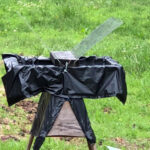What Type Of Plane Am I Flying On? This is a common question among travelers, and at flyermedia.net, we understand the importance of knowing the aircraft you’ll be boarding. Discover how to identify your plane model and its configuration, find specific aircraft features, and address safety concerns. Uncover a world of aviation insights to enhance your travel experience, exploring everything from seat layouts to airline fleet details. Let’s dive into the specifics of aircraft identification, seat configurations, and airline insights.
1. Why Knowing Your Aircraft Type Matters
Why should I care about what kind of plane I’m flying on? There are several key reasons to pay attention to the type of aircraft you’ll be flying on, primarily revolving around comfort, experience, and, for some, peace of mind.
1.1. Seat Configuration: The Comfort Factor
Why is seat configuration so important? The seat configuration is arguably the most important factor. Different aircraft, even within the same airline, can have vastly different seating arrangements, particularly in premium cabins.
Take Emirates, for example, which operates both Boeing 777-300ER and Airbus A380 aircraft. The business class on the 777-300ER features angled-flat seats in a 2-3-2 configuration, which many find less private and more crowded.
 Emirates Boeing 777 Business Class
Emirates Boeing 777 Business Class
In contrast, the A380 business class offers a 1-2-1 configuration, providing significantly more privacy and personal space. Additionally, the A380 boasts a business class bar, adding a unique and enjoyable element to the flying experience. Imagine booking a business class flight expecting the A380 experience, only to find yourself on a 777-300ER.
1.2. The Quest for a Specific Aircraft
Why would someone want to fly on a specific aircraft? Some travelers have specific aircraft they wish to fly on, whether it’s to experience cutting-edge cabin features or to check off a bucket list item.
For example, Singapore Airlines’ First Class Suites are exclusively available on their A380 aircraft. For discerning luxury travelers and aviation enthusiasts, flying on such an aircraft is a must.
1.3. Aircraft Age: A Matter of Curiosity
Does the age of a plane really matter? While modern aviation is incredibly safe, some passengers are curious about the age of the aircraft they will be flying on. Knowing the age can be a matter of personal preference, satisfying curiosity about the aircraft’s history.
1.4. Avoiding Specific Aircraft: Peace of Mind
Is it rational to avoid certain aircraft? Despite the overwhelming safety of commercial aviation, some individuals may prefer to avoid specific aircraft types due to past incidents or personal concerns. Even though the Boeing 737 MAX has been recertified and is widely in use, some travelers remain apprehensive about flying on it.
2. Finding the Details of Your Plane
How can I find out what type of plane I’m flying on? Identifying the details of your flight involves a few simple steps using online tools and airline resources.
2.1. Determining Seat Configuration
How do I find the seat configuration of my flight? To determine the seat configuration, ExpertFlyer and SeatGuru are excellent resources. Here’s how to use ExpertFlyer:
- Go to the ExpertFlyer website.
- Create or log into your account.
- Click on Seat Map on the left-hand side.
- Enter the departing and arriving airports, departure date, airline, and flight number, and select the desired cabin class(es).
- Click Search.
- A seat map will appear, showing the layout of the cabin.
For example, ANA (All Nippon Airways) offers both older and newer business class products on the Boeing 777-300ER. ANA’s new business class, known as “The Room,” is significantly more private and spacious compared to the older version.
 ANA New Business Class "The Room"
ANA New Business Class "The Room"
To differentiate between planes with the new and old business class, observe where the business class cabin ends on ExpertFlyer’s seat map. If the cabin ends at row 20, it’s the new business class; if it ends later, it’s the older version.
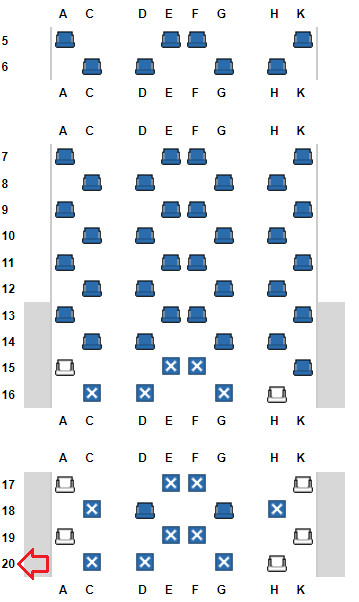 ANA New Business Class Seat Map
ANA New Business Class Seat Map
2.2. Locating a Specific Aircraft
How can I find a flight on a specific aircraft? If you’re looking to fly on a specific aircraft, you’ll need to identify which routes that aircraft operates on.
For example, if you want to fly on Singapore Airlines’ A380, you can use Planespotters.net to find which cities Singapore Airlines flies to with the A380. Scroll to the bottom of the page to find a list of aircraft in Singapore Airlines’ fleet, organized by tail number. Note the tail numbers of all A380 aircraft.
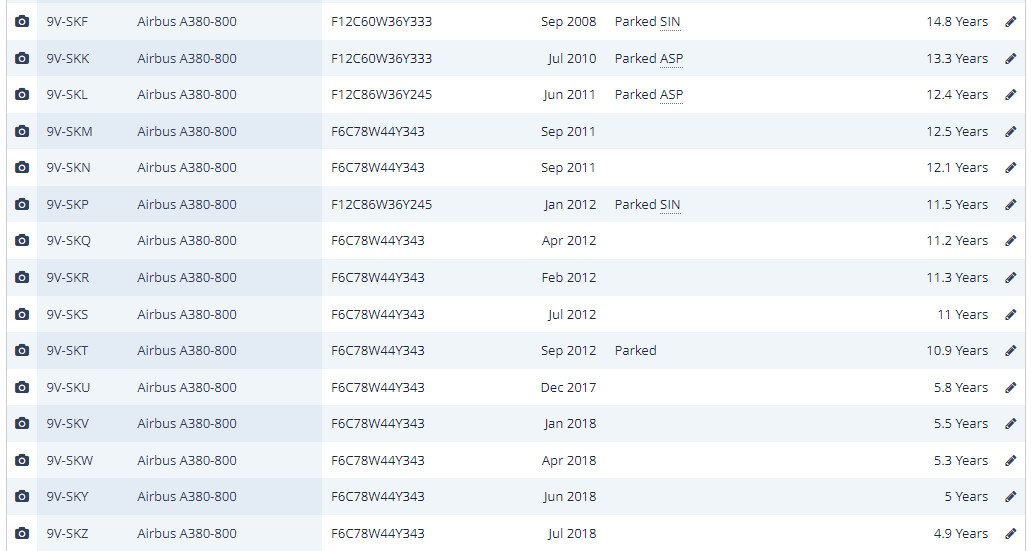 Singapore Airlines A380 Planespotters
Singapore Airlines A380 Planespotters
Next, go to FlightRadar24.com and enter the tail number in the search box to view the aircraft’s flight history. This will help you infer the routes that aircraft has historically flown, increasing your chances of booking a flight on one of those A380s.
For instance, if an aircraft has been flying between London-Heathrow (LHR) and Singapore (SIN), booking a flight on that route increases your probability of flying on the desired A380.
2.3. Discovering the Age of an Aircraft
How can I find out how old a plane is? You can easily find the age of a plane on Planespotters.net. The site provides details about the aircraft’s age, production location, and operator history.
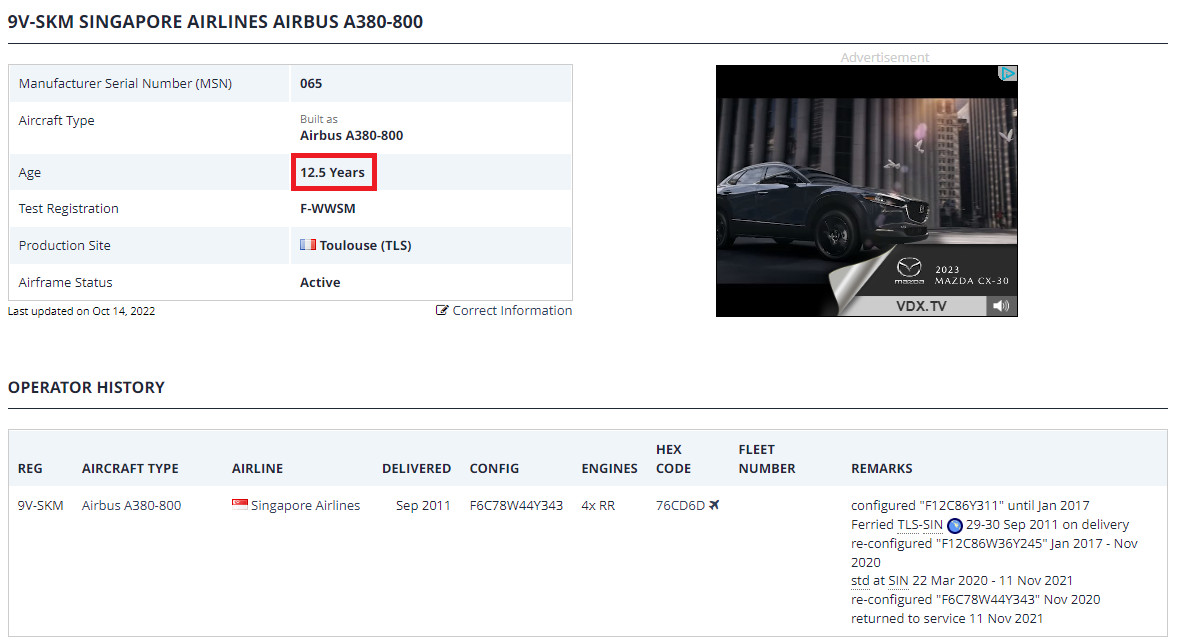 Singapore A380 9V-SKM History
Singapore A380 9V-SKM History
2.4. Addressing Safety Concerns
How can I avoid flying on a specific type of aircraft? If you have safety concerns and wish to avoid specific aircraft types, SeatGuru and Google Flights can help.
To use SeatGuru:
- Visit SeatGuru’s website.
- Enter your flight details and click Find.
- Look under the Aircraft column to see the aircraft operating your flight.
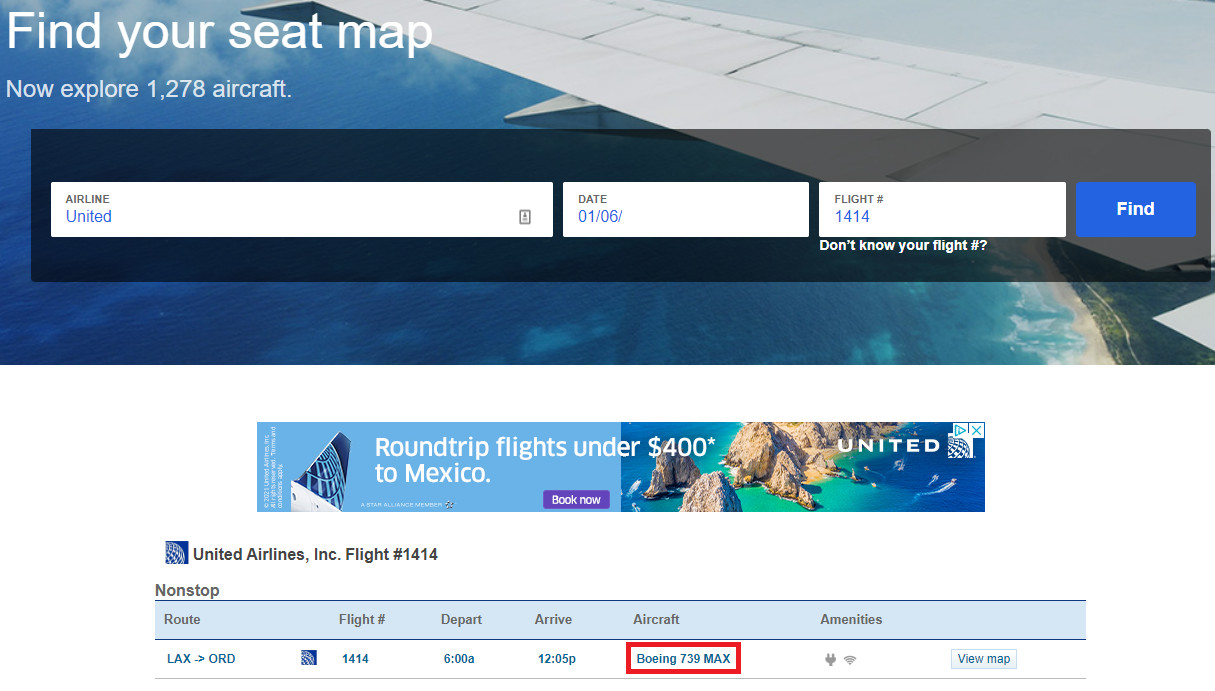 United 737 MAX SeatGuru
United 737 MAX SeatGuru
To use Google Flights:
- Visit Google Flights’ homepage.
- Enter your flight details and select a flight.
- Click the down arrow button on the right-hand side to expand the flight details.
- The plane type will be listed at the bottom of the flight option’s box.
It’s important to note that SeatGuru’s information can sometimes be inaccurate. Always cross-reference with other sources like ExpertFlyer or the airline’s website for the most up-to-date details.
For instance, SeatGuru might show an outdated seat configuration for a United Polaris business class flight.
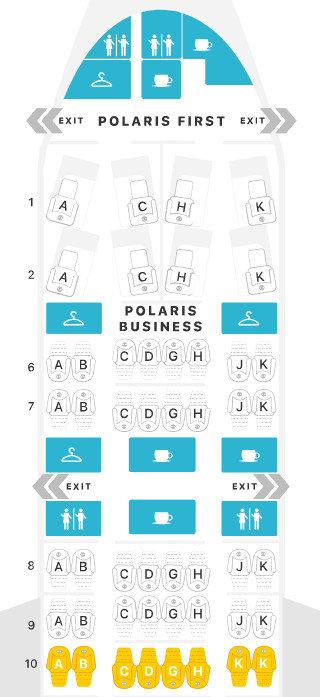 IAH EZE SeatGuru
IAH EZE SeatGuru
However, United and ExpertFlyer will reflect the updated cabin configuration after a retrofit.
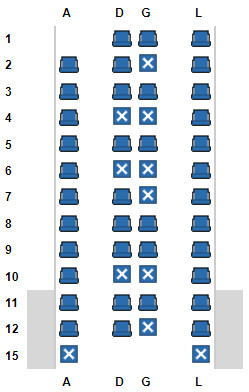 IAH EZE ExpertFlyer
IAH EZE ExpertFlyer
3. Tools for Aircraft Identification and Analysis
What are the best tools to identify aircraft types? Several online tools can help you identify the aircraft you’re flying on and analyze its features.
3.1. ExpertFlyer
Why is ExpertFlyer a reliable tool? ExpertFlyer provides detailed seat maps and aircraft information, making it easier to identify seat configurations and cabin layouts. While generally reliable, it may occasionally have incomplete information.
3.2. SeatGuru
How can SeatGuru help me? SeatGuru is a popular tool for finding seat maps and aircraft details. However, it’s not always reliable, so cross-referencing its data with other sources is essential.
3.3. Planespotters.net
What makes Planespotters.net unique? Planespotters.net offers comprehensive information about aircraft, including their age, history, and current operator. It is a reliable source for tracking specific aircraft.
3.4. FlightRadar24.com
How can I track a specific plane using FlightRadar24? FlightRadar24.com allows you to track the real-time location and historical flights of specific aircraft, helping you determine the routes they typically fly.
3.5. Google Flights
Is Google Flights useful for finding aircraft details? Google Flights provides aircraft information alongside flight details, making it a convenient tool for quick checks. However, the information may sometimes be incomplete.
3.6. Airline’s Website
Why should I check the airline’s website? The airline’s website is generally the most reliable source of information about the aircraft operating your flight. It provides the most accurate and up-to-date details.
4. The Role of Aircraft Type in Flight Safety and Passenger Experience
How does the aircraft type influence flight safety? Different aircraft types are subject to different safety regulations and maintenance schedules. Modern aircraft are equipped with advanced safety features, and airlines adhere to strict safety protocols, ensuring a high level of safety across all aircraft types.
4.1. Passenger Comfort and Amenities
How does aircraft type affect passenger comfort? The aircraft type significantly impacts passenger comfort and the amenities available. Newer aircraft often feature improved cabin layouts, better entertainment systems, and enhanced air quality. For example, the Airbus A350 and Boeing 787 Dreamliner are known for their improved cabin pressure and humidity, reducing jet lag.
Different aircraft also offer different seat types and configurations, especially in premium cabins. Some aircraft feature lie-flat beds in business class, while others offer angled-flat seats. Knowing the aircraft type allows passengers to choose flights that provide the desired level of comfort.
4.2. Environmental Impact and Fuel Efficiency
Are some aircraft more environmentally friendly than others? Newer aircraft are designed to be more fuel-efficient and environmentally friendly. For instance, the Boeing 787 Dreamliner uses advanced materials and engine technology to reduce fuel consumption and emissions. Airlines are increasingly investing in these newer aircraft to lower their carbon footprint and operating costs.
4.3. Aircraft Performance and Capabilities
How does aircraft performance affect my flight? Different aircraft types have varying performance capabilities, such as range, speed, and altitude. These factors can affect flight duration and the routes an airline can operate. For example, ultra-long-range aircraft like the Airbus A350-900ULR can fly non-stop between distant cities, offering passengers more convenient travel options.
4.4. Impact on Airport Infrastructure
Do different aircraft require different airport facilities? Yes, different aircraft types require different airport facilities. Larger aircraft like the Airbus A380 need specialized gates, taxiways, and runways to accommodate their size and weight. Airports that handle these aircraft must invest in infrastructure upgrades to ensure safe and efficient operations.
5. Practical Tips for Enhancing Your Flight Experience
How can I use aircraft information to enhance my flight? With a bit of research, you can use aircraft information to make informed decisions and improve your overall flight experience.
5.1. Choosing the Best Seats
How do I select the best seats on my flight? Use seat maps on ExpertFlyer or SeatGuru to identify the best seats based on your preferences. Consider factors such as legroom, proximity to restrooms, and window or aisle preferences. Some seats may be designated as “preferred” or “extra legroom,” which may require an additional fee.
5.2. Planning for Layover Time
How does the aircraft type affect layover times? The aircraft type can influence layover times, especially at airports that require specialized handling for larger aircraft. If you’re connecting to a flight on an A380, ensure you have sufficient time for transfers, as the boarding and deplaning processes may take longer.
5.3. Utilizing In-Flight Amenities
What amenities are available on different aircraft types? Different aircraft types offer varying in-flight amenities, such as Wi-Fi, entertainment systems, and power outlets. Research the aircraft type to ensure it offers the amenities you need for a comfortable flight. For example, some aircraft have personal entertainment screens at every seat, while others rely on overhead screens.
5.4. Understanding Cabin Layouts
How can I understand the cabin layout of my flight? Understanding the cabin layout helps you choose the best seats and plan for your journey. Use seat maps to identify the location of restrooms, galleys, and emergency exits. Familiarize yourself with the seat configuration, especially in premium cabins, to ensure you get the desired level of comfort and privacy.
5.5. Preparing for Potential Delays
Can knowing the aircraft type help me prepare for delays? Yes, knowing the aircraft type can help you prepare for potential delays. Some aircraft types may be more prone to mechanical issues than others. Stay informed about the aircraft’s history and maintenance record to anticipate potential disruptions.
6. Recent Trends and Innovations in Aircraft Technology
What are the latest advancements in aircraft technology? The aviation industry is constantly evolving, with new technologies and innovations aimed at improving safety, efficiency, and passenger comfort.
6.1. Sustainable Aviation Fuels (SAF)
How are sustainable aviation fuels changing the industry? Sustainable aviation fuels (SAF) are gaining traction as a way to reduce the environmental impact of flying. SAF are produced from renewable sources, such as biomass and waste materials, and can significantly lower carbon emissions. Airlines are increasingly investing in SAF to meet their sustainability goals.
6.2. Electric and Hybrid-Electric Aircraft
What is the future of electric aircraft? Electric and hybrid-electric aircraft are being developed for short-haul flights. These aircraft use batteries and electric motors to reduce noise and emissions. While fully electric commercial flights are still some years away, hybrid-electric aircraft are expected to enter service sooner, offering a more sustainable alternative for regional travel.
6.3. Advanced Air Mobility (AAM)
What is Advanced Air Mobility? Advanced Air Mobility (AAM) refers to new modes of air transportation, such as electric vertical takeoff and landing (eVTOL) aircraft. AAM aims to provide faster and more efficient transportation within urban areas. eVTOL aircraft are being developed for air taxi services, offering an alternative to ground-based transportation.
6.4. Autonomous Flight Technology
How close are we to autonomous planes? Autonomous flight technology is advancing rapidly, with the potential to revolutionize the aviation industry. While fully autonomous commercial flights are not yet a reality, many aircraft already use autonomous systems for certain tasks, such as autopilot and landing assistance. Autonomous technology promises to improve safety, efficiency, and reduce pilot workload.
6.5. Enhanced Connectivity and In-Flight Entertainment
How is connectivity improving on planes? Airlines are investing in enhanced connectivity and in-flight entertainment systems to provide passengers with a more enjoyable travel experience. Newer aircraft offer high-speed Wi-Fi, allowing passengers to stay connected and productive during their flights. In-flight entertainment systems feature a wide selection of movies, TV shows, and games, providing hours of entertainment.
7. Understanding Aviation Regulations and Safety Standards
Who regulates aviation safety? Aviation is heavily regulated to ensure the safety of passengers and crew. Regulatory bodies such as the Federal Aviation Administration (FAA) in the United States and the European Union Aviation Safety Agency (EASA) set and enforce safety standards for aircraft design, maintenance, and operation.
7.1. Aircraft Certification and Maintenance
How are aircraft certified for safety? Aircraft manufacturers must obtain certification from regulatory authorities before they can sell their aircraft. The certification process involves rigorous testing and evaluation to ensure the aircraft meets all safety standards. Airlines must also adhere to strict maintenance schedules to keep their aircraft in safe operating condition.
7.2. Pilot Training and Licensing
What training do pilots undergo? Pilots undergo extensive training and must obtain a license from regulatory authorities before they can operate commercial aircraft. The training includes classroom instruction, simulator training, and flight experience. Pilots must also undergo regular recurrent training to maintain their skills and knowledge.
7.3. Air Traffic Control Systems
How does air traffic control ensure safety? Air traffic control (ATC) systems play a crucial role in ensuring the safe and efficient flow of air traffic. ATC controllers use radar and communication systems to monitor aircraft and provide guidance to pilots. ATC systems are designed to prevent collisions and manage air traffic in a safe and orderly manner.
7.4. Emergency Procedures and Safety Equipment
What safety equipment is required on planes? Commercial aircraft are equipped with a range of emergency procedures and safety equipment to protect passengers and crew in the event of an emergency. This includes emergency exits, oxygen masks, life vests, and fire extinguishers. Airlines conduct regular safety briefings to inform passengers about emergency procedures.
8. The Future of Aviation: What’s Next?
What innovations are on the horizon for air travel? The aviation industry is constantly evolving, with new technologies and innovations on the horizon that promise to transform the way we travel.
8.1. Supersonic and Hypersonic Travel
When will we see supersonic planes again? Supersonic and hypersonic travel are making a comeback, with companies developing new aircraft that can fly faster than the speed of sound. Supersonic aircraft could significantly reduce travel times on long-haul routes, while hypersonic aircraft could potentially fly from New York to London in just a few hours.
8.2. Space Tourism
Can I travel to space? Space tourism is becoming a reality, with companies offering suborbital and orbital flights to paying customers. While space tourism is currently limited to the wealthy, the cost is expected to come down over time, making space travel more accessible to the general public.
8.3. Digitalization and Automation
How are digital technologies changing air travel? Digitalization and automation are transforming the aviation industry, with new technologies being used to improve efficiency, safety, and passenger experience. This includes the use of artificial intelligence (AI) to optimize flight routes, predictive maintenance to prevent mechanical issues, and biometric identification to streamline airport security.
8.4. Personalized Travel Experiences
How will air travel become more personalized? Airlines are increasingly focused on providing personalized travel experiences to meet the individual needs and preferences of their passengers. This includes offering customized entertainment options, personalized meal choices, and tailored service. Airlines are using data analytics to understand passenger preferences and provide a more personalized travel experience.
9. Addressing Common Misconceptions About Air Travel
What are some common myths about air travel? There are many misconceptions about air travel, ranging from safety concerns to the impact of turbulence.
9.1. Is Air Travel Safe?
How safe is flying compared to driving? Air travel is statistically one of the safest modes of transportation. The risk of being involved in an accident is far lower than with driving. Airlines and regulatory authorities invest heavily in safety measures to minimize the risk of accidents.
9.2. Does Turbulence Pose a Safety Risk?
Is turbulence dangerous? Turbulence can be uncomfortable, but it is rarely dangerous. Modern aircraft are designed to withstand even severe turbulence, and pilots are trained to handle it safely. In most cases, turbulence is simply a minor inconvenience.
9.3. Is Cabin Air Unhealthy?
Is the air on planes unhealthy? Cabin air is often perceived as being dry and unhealthy, but modern aircraft use sophisticated air filtration systems to maintain air quality. The air is a mixture of fresh air and recirculated air that has been filtered to remove dust, allergens, and other contaminants.
9.4. Do Mobile Phones Interfere with Aircraft Systems?
Can my phone really affect the plane? The use of mobile phones on aircraft has been a subject of debate for many years. While there is no conclusive evidence that mobile phones interfere with aircraft systems, airlines often require passengers to turn off their phones or put them in airplane mode during takeoff and landing as a precautionary measure.
10. Resources for Aviation Enthusiasts and Professionals
Where can I find more information about aviation? Numerous resources are available for aviation enthusiasts and professionals who want to learn more about the industry.
10.1. Aviation Museums and Historical Sites
What can I learn at an aviation museum? Aviation museums and historical sites offer a fascinating glimpse into the history of flight. These museums showcase historic aircraft, exhibits, and artifacts that tell the story of aviation’s evolution.
10.2. Aviation Magazines and Publications
What are the best aviation magazines? Aviation magazines and publications provide in-depth coverage of the latest news, trends, and technologies in the industry. These publications cover a wide range of topics, from aircraft design and maintenance to airline operations and pilot training.
10.3. Aviation Conferences and Trade Shows
How can I network with aviation professionals? Aviation conferences and trade shows offer opportunities to network with professionals, learn about new products and services, and stay up-to-date on the latest industry developments.
10.4. Aviation Blogs and Online Communities
Where can I discuss aviation with others online? Aviation blogs and online communities provide a platform for enthusiasts and professionals to share their knowledge, experiences, and opinions about the industry. These online resources offer a wealth of information and opportunities to connect with like-minded individuals.
Flyermedia.net offers a diverse range of information, news, and resources for anyone passionate about aviation. Explore our site to discover more about flight training, aviation careers, and the latest industry trends.
Address: 600 S Clyde Morris Blvd, Daytona Beach, FL 32114, United States
Phone: +1 (386) 226-6000
Website: flyermedia.net
Embark on your aviation journey with flyermedia.net and let your dreams take flight.
FAQ: What Type of Plane Am I Flying On?
1. How can I find out what type of plane I’m flying on before booking my ticket?
You can usually find the aircraft type on the airline’s website during the booking process or by using websites like SeatGuru or ExpertFlyer after booking.
2. Why does the type of aircraft matter for my flight experience?
The aircraft type can affect seat comfort, cabin layout, available amenities, and overall flight experience, particularly in premium cabins.
3. What is the best website to check seat configurations for different aircraft?
ExpertFlyer and SeatGuru are popular websites for checking seat configurations, but always cross-reference the information with the airline’s website.
4. How can I avoid flying on a specific type of aircraft that I am uncomfortable with?
Use websites like SeatGuru or Google Flights to identify the aircraft type before booking and choose a different flight if needed.
5. Is it possible to request a specific aircraft type when booking a flight?
While not always guaranteed, you can try contacting the airline directly to request a flight operated by a specific aircraft, but it depends on availability and airline policies.
6. What are the benefits of flying on newer aircraft models?
Newer aircraft often have better fuel efficiency, more comfortable cabins, advanced entertainment systems, and improved air quality.
7. How do sustainable aviation fuels (SAF) impact the type of aircraft I might be flying on?
SAF can be used in existing aircraft, so you may be flying on a plane using SAF without even knowing it, contributing to a more sustainable flight.
8. Where can I find reliable information about the age and history of an aircraft?
Websites like Planespotters.net provide detailed information about aircraft age, production history, and operator history.
9. Can the type of aircraft affect the duration of my flight?
Different aircraft types have varying performance capabilities, such as speed and range, which can affect flight duration, especially on long-haul routes.
10. How do aviation regulations ensure the safety of different aircraft types?
Aviation regulations and safety standards are rigorous and apply to all aircraft types, ensuring that they meet stringent safety requirements for design, maintenance, and operation.
